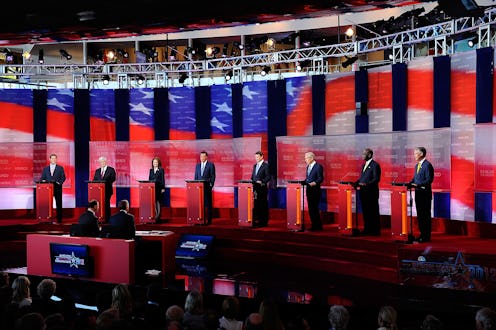News
This Isn't The Biggest Presidential Field Ever
Over the past several weeks, a lot of conversation's been had about the positively huge projected field of Republican presidential candidates. Sure, the Democrats may be playing things a little cooler — only three candidates have come out to challenge Hillary Clinton's front-running campaign. But when you add them all together, you have to wonder: is this the biggest presidential field ever?
For some perspective, the 2012 GOP field boasted 11 candidates (12 if you count Gary Johnson, who eventually dropped out and ran as a member of the Libertarian Party). By comparison, the 2016 field may be a veritable mosh pit, with political observers keeping an eye on as many as 20 feasible Republican candidates waiting in the wings (12 have already announced), in addition to the four Democrats. On the Republican side, the number is going to be problematic — in the first Fox News-hosted debate of the primary season, only 10 Republican candidates will be allowed to take the stage, the order to be determined by an average of their last five national polls.
So, has the modern political era ever been a bigger presidential field than we're staring down now? Let's take a little traipse through history and find out.
One major point to bear in mind: presidential fields are generally smaller when there's an incumbent, because (with rare exception) they won't be challenged from within their own party. As such, 2016 is one of those perfect storm kinda cycles — a two-term president on the way out, and candidates from both sides vying to replace him. And, obviously, there's no telling just yet how many candidates will actually make it official.
But if you simply take the four Democrats currently in the race, and the 12 Republicans — the last of which, brusque businessman Donald Trump, announced on Tuesday — you've already got 16 candidates in the running. And that's without presumed entrants like Scott Walker, Bobby Jindal, John Kasich, and Chris Christie for the Republicans, as well as former Virginia Senator Jim Webb, widely rumored to be mulling a run for the Democrats.
So, let's assume that all of those people jump in the race. What's the final tally? It would then come to a whopping 21, a big number indeed.
But that would not be the biggest field in presidential history, not even recent presidential history. That title would still go to 2008 and 1988, both cycles that featured 22 different candidates across the two parties. Obviously, it wouldn't be that shocking if one more person jumped in the race in 2016, so that number could easily be tied, but 2008 was a real fracas, with crowded fields on both sides of the aisle.
By contrast, the numbers are a lot slimmer going back into recent political history:
- 2004, an incumbent year for George W. Bush, saw just 9 Democrats and Republicans campaign, in addition to Green Party candidate Ralph Nader in the spoiler role.
- The 2000 campaign season boasted 15 candidates from the two parties, only three of them Democrats — incumbent vice president Al Gore's only real challenge was New York Senator Bill Bradley.
- In 1996, the field was narrower still, at just major party 11 candidates.
- In 1992, the field in both parties topped out at just ten candidates, nine Democrats against incumbent Republican George H.W. Bush.
Simply put, while this current year could end up falling short of the heaviest field in history, there's no denying the chaos. And it's even more striking considering how relatively few Democrats are running — if you're speaking strictly in terms of Republican candidates, it's likely that this will indeed be the biggest GOP field in American history.
Images: Getty Images (3)
